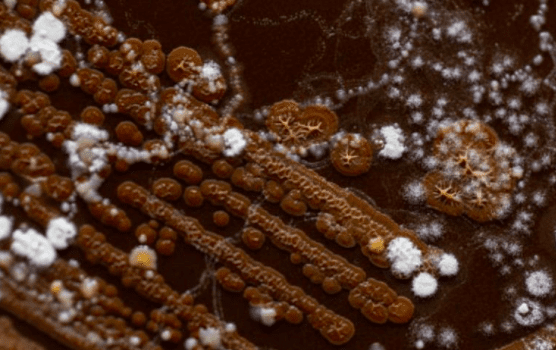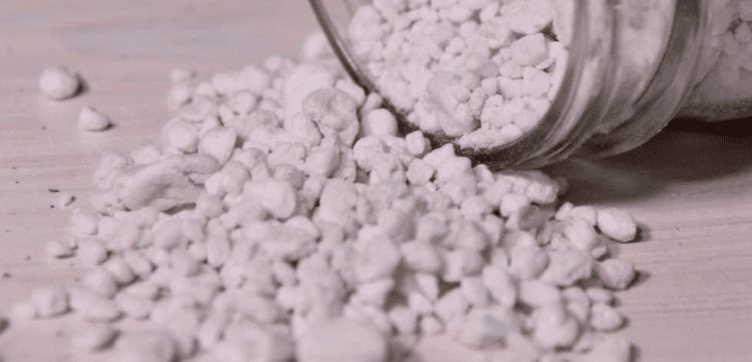Have you ever seen little white balls in your garden soil? If so, you’re not alone! These little spheres are actually quite common, but many people don’t know what they are or why they’re there. In this blog post, we will discuss the purpose of these mysterious little balls and how to get rid of them if necessary.
What Are the White Balls in Soil?
The white balls found in your soil are either fungus balls or pieces of perlite. If the balls suddenly appeared one day, then they are most likely balls of fungus. Perlite is added as an ingredient to potting mixes, so it should have been there when you first got your plant or changed the soil.
Perlite is nothing to worry about. In fact, it’s simply a type of volcanic glass that is often used in gardening and horticulture. It has a very porous surface, which makes it ideal for aerating the soil and helping roots to grow.
Fungus balls, on the other hand, are exactly what they sound like – balls of fungi! They are often found in moist soil and can be either white or brown in color. While they are not too harmful to plants, many gardeners choose to remove them from their soil.
How to Remove Fungus Balls from Soil?
If you want to get rid of the fungus balls in your soil, there are a few different methods you can try. The easiest method is to just scrap the surface layer of soil where the fungus balls are present. You can also try to remove them with a garden fork or trowel.
Another method is to completely repot your plant. This will give you the opportunity to start with fresh, clean soil. You can also add a fungicide to your plant’s new soil to kill off any remaining fungal spores that may be present.
Using fungicide is generally considered the most effective method for getting rid of fungus balls. You can find fungicides at your local garden center or nursery. Be sure to follow the instructions on the label carefully, as some products may be harmful to plants if used incorrectly.
Neem oil is my go-to fungicide for most garden problems. It’s a natural product made from the seeds of the neem tree, and it’s very effective at killing fungi. You can usually find it in liquid or granular form.

Are Fungus Balls Damaging to Plants?
No, fungus balls won’t cause too much harm to your plants. However, they can sometimes compete with plant roots for moisture and nutrients. If you notice your plants struggling, it may be due to the presence of fungus balls in the soil.
The presence of the fungus can also lead to plant diseases, such as root rot. If you notice any of these problems, be sure to remove the fungus balls from your soil right away.
Leaving fungus can result in it spreading to other areas of the plant and to other plants in the garden. Besides, it looks gross, right? No one wants to see loads of white balls in their garden. So, if you spot them, be sure to take care of the problem right away!
How to Prevent White Fungus Balls in Soil?
Now that you’ve got rid of them, you’re probably wondering how to prevent white balls in soil. The best way to prevent fungus balls is to make sure your plant’s pot has good drainage.
You see, the fungus thrives in moist conditions. By ensuring that your plant’s pot has good drainage, you can help to keep the soil dry and prevent the fungus from growing.
This also means being careful with how much water you’re giving your plant. Water your plant only when the soil is dry to the touch – overwatering can lead to problems like fungus growth.
If you’re still worried about white balls in your soil, you can always add perlite to your potting mix (another white ball). This will help to aerate the soil and keep it from getting too compacted.
How Long Do Fungus Balls Live In Soil?
Fungus balls can live in soil for years, especially if the conditions are ideal for their growth. However, they need decaying matter to survive. Once this matter is gone, the fungus will start to die off.
You can speed up the process by removing the balls from your soil and increasing air circulation around your plants. This will help to dry out the soil and make it less hospitable for the fungus.
Should I Remove Perlite from Soil?
No, you don’t need to remove perlite from your soil. In fact, as we mentioned before, perlite can actually be beneficial for your plant! It helps to aerate the soil and keeps it from getting too compacted.
Here’s a full list of perlite benefits:
- Aeration
- Drainage
- Root growth
- Prevents soil compaction
- Keeps potting mix light
- Lasts for years
- Economical
As you can see, there are many benefits to using perlite in your soil. They are added to the soil for a reason, so there’s no need to remove them!

The only time when you may want less perlite in your soil is if you’re growing plants that prefer a more compacted environment, or if there’s too much perlite in the soil.
In fact, perlite can be the solution to the other type of white balls – fungus! it can help to aerate the soil and prevent the fungus from growing.
Conclusion
In conclusion, the white balls in your soil are most likely either pieces of perlite or fungus balls. Perlite is nothing to worry about and can actually be beneficial for your plant. Fungus balls, while not harmful, can be unsightly.
If you want to get rid of them, you can try scraping the surface layer of soil or repotting your plant. You can also prevent them from growing in the first place by ensuring that your plant’s pot has good drainage. Thanks for reading!
Do you have any questions or comments about white balls in soil? Let us know in the comments below! And be sure to check out our other gardening blog posts for more helpful tips and advice. Happy gardening!
Tim is an avid gardener from the UK. He was the founder of PlantCarer.com from 2021 to Sep 2023. He sold PlantCarer.com to Aaron. He has since started his own business called Seed To Supper, which provides new gardeners all the materials you need in a box (pots, seeds, compost and instructions) to grow your own delicious and nutritious vegetables and herbs from start to finish – no garden required.









0 Comments